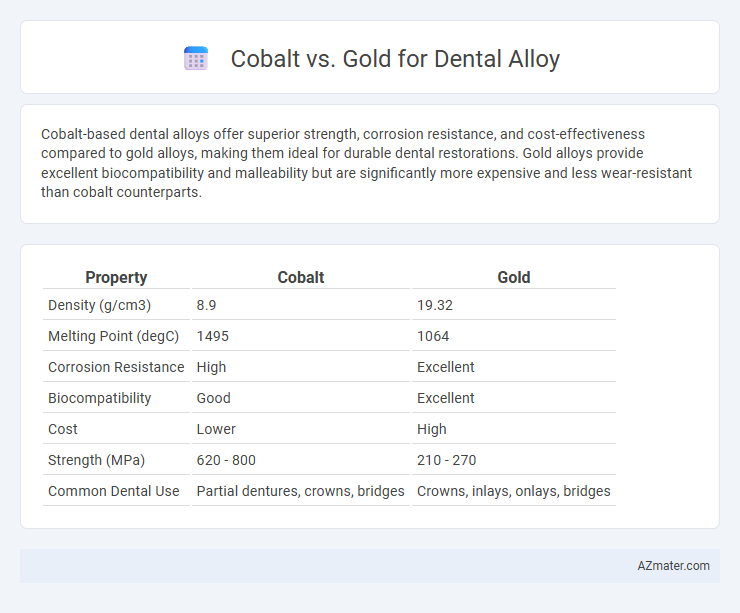Cobalt-based dental alloys offer superior strength, corrosion resistance, and cost-effectiveness compared to gold alloys, making them ideal for durable dental restorations. Gold alloys provide excellent biocompatibility and malleability but are significantly more expensive and less wear-resistant than cobalt counterparts.
Table of Comparison
| Property | Cobalt | Gold |
|---|---|---|
| Density (g/cm3) | 8.9 | 19.32 |
| Melting Point (degC) | 1495 | 1064 |
| Corrosion Resistance | High | Excellent |
| Biocompatibility | Good | Excellent |
| Cost | Lower | High |
| Strength (MPa) | 620 - 800 | 210 - 270 |
| Common Dental Use | Partial dentures, crowns, bridges | Crowns, inlays, onlays, bridges |
Overview of Dental Alloys
Dental alloys such as cobalt-chromium and gold are widely used for their strength, biocompatibility, and corrosion resistance in restorative dentistry. Cobalt alloys offer excellent hardness and are cost-effective, making them ideal for frameworks in removable partial dentures and crowns, while gold alloys provide superior malleability, corrosion resistance, and longevity, often preferred for high-precision restorations and long-term durability. The selection between cobalt and gold dental alloys depends on factors like mechanical properties, aesthetic requirements, and budget considerations in prosthodontic treatments.
Composition of Cobalt-Based Dental Alloys
Cobalt-based dental alloys primarily consist of cobalt, chromium (typically 20-30%), and small amounts of molybdenum, enhancing corrosion resistance and mechanical strength. These alloys often contain nickel and traces of iron to improve ductility and workability, distinguishing them from gold-based alloys, which are predominantly gold and platinum group metals. The superior hardness and biocompatibility of cobalt-chromium alloys make them a cost-effective alternative to gold for dental restorations.
Properties of Gold-Based Dental Alloys
Gold-based dental alloys exhibit excellent biocompatibility and corrosion resistance, making them highly durable for dental restorations. Their malleability allows for precise shaping and adaptation to tooth structures, enhancing longevity and patient comfort. These alloys also provide superior aesthetic qualities due to their natural metallic luster and resistance to tarnish compared to cobalt alloys.
Biocompatibility: Cobalt vs Gold
Gold dental alloys exhibit superior biocompatibility due to their inert nature, resulting in minimal allergic reactions and reduced risk of corrosion in the oral environment. Cobalt-chromium alloys, while durable and cost-effective, have higher potential for causing hypersensitivity and ion release, which may lead to local tissue irritation or allergic responses. Studies indicate gold alloys maintain stable oral pH compatibility and promote better long-term gum tissue health compared to cobalt-based alternatives.
Mechanical Strength and Durability
Cobalt-based dental alloys exhibit superior mechanical strength and corrosion resistance compared to gold alloys, making them ideal for load-bearing restorations such as crowns and bridges. Gold alloys offer excellent biocompatibility and ease of casting but have lower yield strength and hardness, which may reduce durability under high stress. The inherent wear resistance and fatigue strength of cobalt alloys contribute to their longer lifespan in restorative dental applications.
Corrosion Resistance in Oral Environment
Cobalt-chromium alloys exhibit superior corrosion resistance in the oral environment compared to gold alloys due to their stable passive oxide layer, which effectively prevents metal ion release and degradation. Gold alloys, while biocompatible and resistant to tarnishing, are more susceptible to corrosion under acidic conditions commonly found in the mouth. The enhanced durability of cobalt-based alloys makes them preferable for long-term dental restorations exposed to fluctuating pH and salivary enzymes.
Aesthetic Outcomes and Color Stability
Cobalt-chromium alloys in dental applications offer excellent strength and corrosion resistance but tend to exhibit a less natural metallic luster compared to gold alloys, impacting overall aesthetic outcomes. Gold alloys provide superior color stability and a warm, natural hue that closely mimics the appearance of natural teeth, enhancing long-term cosmetic appeal. Studies show gold's resistance to oxidation maintains its color integrity over time, whereas cobalt alloys may develop surface discoloration, affecting their visual consistency in restorative dentistry.
Cost Comparison: Cobalt vs Gold Alloys
Cobalt alloys are significantly more cost-effective than gold alloys in dental applications, with cobalt prices typically a fraction of the high value of gold per gram. Gold alloys offer superior corrosion resistance and biocompatibility but their expense can be 10 to 20 times higher than cobalt-based alternatives. Dental clinics often choose cobalt alloys for budget-conscious treatments without compromising structural integrity.
Clinical Applications and Indications
Cobalt-chromium alloys are commonly used in dental prosthetics due to their high strength, corrosion resistance, and biocompatibility, making them ideal for frameworks in removable partial dentures and implant-supported restorations. Gold alloys, known for their excellent malleability and superior corrosion resistance, are preferred in crown and bridge applications where precision fit and longevity in the oral environment are critical. Clinical indications for cobalt include cost-effective, durable frameworks especially in patients with metal sensitivities, while gold remains the material of choice for esthetically demanding restorations requiring minimal wear and excellent tissue compatibility.
Choosing the Right Alloy: Factors to Consider
Cobalt-chromium alloys offer superior strength, corrosion resistance, and cost-effectiveness compared to gold alloys, making them ideal for long-lasting dental restorations. Gold alloys, known for their excellent biocompatibility, malleability, and minimal wear on opposing teeth, are preferred in cases requiring high precision and aesthetics. When choosing between cobalt and gold alloys, factors such as patient allergies, occlusal forces, restoration type, budget constraints, and desired longevity must be carefully evaluated to ensure optimal clinical outcomes.

Infographic: Cobalt vs Gold for Dental alloy
 azmater.com
azmater.com